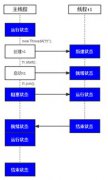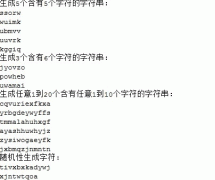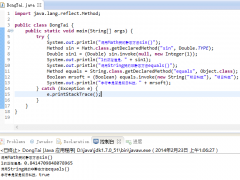Java 范型攻略篇
在已发布的Java1.4中在核心代码库中增加了许多新的API(如Loging,正则表达式,NIO)等,在最新发布的JDK1.5和即将发布的JDK1.6中也新增了许多API,其中比较有重大意义的就是Generics(范型)。
在已发布的Java1.4中在核心代码库中增加了许多新的API(如Loging,正则表达式,NIO)等,在最新发布的JDK1.5和即将发布的JDK1.6中也新增了许多API,其中比较有重大意义的就是Generics(范型)。
一.什么是Generics?
Generics可以称之为参数类型(parameterized types),由编译器来验证从客户端将一种类型传送给某一对象的机制。如Java.util.ArrayList,
编译器可以用Generics来保证类型安全。
在我们深入了解Generics之前,我们先来看一看当前的java 集合框架(Collection)。在j2SE1.4中所有集合的Root Interface是Collection
Collections example without genericity: Example 1
1 protected void collectionsExample() {
2 ArrayList list = new ArrayList();
3 list.add(new String("test string"));
4 list.add(new Integer(9)); // purposely placed here to create a runtime ClassCastException
5 inspectCollection(list);
6 }
7
8
9 protected void inspectCollection(Collection aCollection) {
10 Iterator i = aCollection.iterator();
11 while (i.hasNext()) {
12 String element = (String) i.next();
13 }
14 }以上的样例程序包含的两个方法,collectionExample方法建立了一个简单的集合类型ArrayList,并在ArrayList中增加了一个String和一个Integer对象.而在inspecCollection方法中,我们迭代这个ArrayList用String进行Cast。我们看第二个方法,就出现了一个问题,Collection在内部用的是Object,而我们要取出Collection中的对象时,需要进行Cast,那么开发者必需用实际的类型进行Cast,像这种向下造型,编译器无
法进行检查,如此一来我们就要冒在代码在运行抛出ClassCastException的危险。我们看inspecCollection方法,编译时没有问题,但在运行时就会抛出ClassCastException异常。所以我们一定要远离这个重大的运行时错误
二.使用Generics
从上一章节中的CassCastException这种异常,我们期望在代码编译时就能够捕捉到,下面我们使用范型修改上一章的样例程序。
//Example 2
1 protected void collectionsExample() {
2 ArrayList<String> list = new ArrayList<String>();
3 list.add(new String("test string"));
4 // list.add(new Integer(9)); this no longer compiles
5 inspectCollection(list);
6 }
7
8
9 protected void inspectCollection(Collection<String> aCollection) {
10 Iterator<String> i = aCollection.iterator();
11 while(i.hasNext()) {
12 String element = i.next();
13 }
14 }从上面第2行我们在创建ArrayList时使用了新语法,在JDK1.5中所有的Collection都加入了Generics的声明。例:
//Example 3
1 public class ArrayList<E> extends AbstractList<E> {
2 // details omitted...
3 public void add(E element) {
4 // details omitted
5 }
6 public Iterator<E> iterator() {
7 // details omitted
8 }
9 }这个E是一个类型变量,并没有对它进行具体类型的定义,它只是在定义ArrayList时的类型占位符,在Example 2中的我们在定义ArrayList的实
例时用String绑定在E上,当我们用add(E element)方法向ArrayList中增加对象时, 那么就像下面的写法一样: public void add(String element);因为在ArrayList所有方法都会用String来替代E,无论是方法的参数还是返回值。这时我们在看Example 2中的第四行,编译就会反映出编译错误。
所以在java中增加Generics主要的目的是为了增加类型安全。
通过上面的简单的例子我们看到使用Generics的好处有:
1.在类型没有变化时,Collection是类型安全的。
2.内在的类型转换优于在外部的人工造型。
3.使Java 接口更加强壮,因为它增加了类型。
4.类型的匹配错误在编译阶段就可以捕捉到,而不是在代码运行时。
受约束类型变量
虽然许多Class被设计成Generics,但类型变量可以是受限的
public class C1<T extends Number> { }
public class C2<T extends Person & Comparable> { }
第一个T变量必须继续Number,第二个T必须继续Person和实现Comparable
三.Generics 方法
像Generics类一样,方法和构造函数也可以有类型参数。方法的参数的返回值都可以有类型参数,进行Generics。
//Example 4
1 public <T extends Comparable> T max(T t1, T t2) {
2 if (t1.compareTo(t2) > 0)
3 return t1;
4 else return t2;
5 }这里,max方法的参数类型为单一的T类型,而T类型继续了Comparable,max的参数和返回值都有相同的超类。下面的Example 5显示了max方法的几个约束。
//Example 5
1 Integer iresult = max(new Integer(100), new Integer(200));
2 String sresult = max("AA", "BB");
3 Number nresult = max(new Integer(100), "AAA"); // does not compile
在Example 5第1行参数都为Integer,所以返回值也是Integer,注重返回值没有进行造型。
在Example 5第2行参数都为String,所以返回值也是String,注重返回值没有进行造型。以上都调用了同一个方法。
在Example 5第3行产生以下编译错误:
Example.java:10: incompatible types
found : java.lang.Object&java.io.Serializable&java.lang.Comparable<?>
required: java.lang.Number
Number nresult = max(new Integer(100), "AAA");
这个错误发生是因为编译器无法确定返回值类型,因为String和Integer都有相同的超类Object,注重就算我们修正了第三行,这行代码在运行仍然会报错,因为比较了不同的对象。
四.向下兼容
任何一个新的特色在新的JDK版本中出来后,我们首先关心的是如何于以前编写的代码兼容。也就是说我们编写的Example 1程序不需要任何的改变就可以运行,但是编译器会给出一个"ROW TYPE"的警告。在JDK1.4中编写的代码如何在JVM1.5中完全兼容运行,我们要人工进行一个:Type erasure处理过程
五.通配符
//Example 6
List<String> stringList = new ArrayList<String>(); //1
List<Object> objectList = stringList ;//2
objectList .add(new Object()); // 3
String s = stringList .get(0);//4
乍一看,Example
6是正确的。但stringList本意是存放String类型的ArrayList,而objectList中可以存入任何对象,当在第3行进行处理时,stringList也就无法保证是String类型的ArrayList,此时编译器不答应这样的事出现,所以第3行将无法编译。
//Example 7
void printCollection(Collection<Object> c)
{ for (Object e : c) {
System.out.println(e);
}}
Example 7的本意是打印所有Collection的对象,但是正如Example 6所说的,编译会报错,此时就可以用通配符“?”来修改Example 7
//Example 8
void printCollection(Collection<?> c)
{ for (Object e : c) {
System.out.println(e);
}}
Example 8中所有Collection类型就可以方便的打印了
有界通配符 <T extends Number>(上界) <T super Number>(下界)
六.创建自己的范型
以下代码来自http://www.java2s.com/ExampleCode/Language-Basics
1.一个参数的Generics
//Example 9(没有使用范型)
class NonGen {
Object ob; // ob is now of type Object
// Pass the constrUCtor a reference to
// an object of type Object
NonGen(Object o) {
ob = o;
}
// Return type Object.
Object getob() {
return ob;
}
// Show type of ob.
void showType() {
System.out.println("Type of ob is " +
ob.getClass().getName());
}
}
// Demonstrate the non-generic class.
public class NonGenDemo {
public static void main(String args[]) {
NonGen iOb;
// Create NonGen Object and store
// an Integer in it. Autoboxing still occurs.
iOb = new NonGen(88);
// Show the type of data used by iOb.
iOb.showType();
// Get the value of iOb.
// This time, a cast is necessary.
int v = (Integer) iOb.getob();
System.out.println("value: " + v);
System.out.println();
// Create another NonGen object and
// store a String in it.
NonGen strOb = new NonGen("Non-Generics Test");
// Show the type of data used by strOb.
strOb.showType();
// Get the value of strOb.
// Again, notice that a cast is necessary.
String str = (String) strOb.getob();
System.out.println("value: " + str);
// This compiles, but is conceptually wrong!
iOb = strOb;
v = (Integer) iOb.getob(); // runtime error!
}
} //Example 10(使用范型)
class Example1<T>{
private T t;
Example1(T o){
this.t=o;
}
T getOb(){
return t;
}
void ShowObject(){
System.out.println("对象的类型是:"+t.getClass().getName());
}
}
public class GenericsExample1 {
/**
* @param args
*/
public static void main(String[] args) {
// TODO Auto-generated method stub
Example1<Integer> examplei=new Example1<Integer>(100);
examplei.ShowObject();
System.out.println("对象是:"+examplei.getOb());
Example1<String> examples=new Example1<String>("Bill");
examples.ShowObject();
System.out.println("对象是:"+examples.getOb());
}
}我们来看Example 9没有使用范型,所以我们需要进行造型,而Example 10我们不需要任何的造型
2.二个参数的Generics
//Example 11
class TwoGen<T, V> {
T ob1;
V ob2;
// Pass the constructor a reference to
// an object of type T.
TwoGen(T o1, V o2) {
ob1 = o1;
ob2 = o2;
}
// Show types of T and V.
void showTypes() {
System.out.println("Type of T is " +
ob1.getClass().getName());
System.out.println("Type of V is " +
ob2.getClass().getName());
}
T getob1() {
return ob1;
}
V getob2() {
return ob2;
}
}
public class GenericsExampleByTwoParam {
/**
* @param args
*/
public static void main(String[] args) {
// TODO Auto-generated method stub
TwoGen<Integer, String> tgObj =
new TwoGen<Integer, String>(88, "Generics");
// Show the types.
tgObj.showTypes();
// OBTain and show values.
int v = tgObj.getob1();
System.out.println("value: " + v);
String str = tgObj.getob2();
System.out.println("value: " + str);
}
}3.Generics的Hierarchy
//Example 12
class Stats<T extends Number> {
T[] nums; // array of Number or subclass
// Pass the constructor a reference to
// an array of type Number or subclass.
Stats(T[] o) {
nums = o;
}
// Return type double in all cases.
double average() {
double sum = 0.0;
for(int i=0; i < nums.length; i++)
sum += nums[i].doubleValue();
return sum / nums.length;
}
}
public class GenericsExampleByHierarchy {
/**
* @param args
*/
public static void main(String[] args) {
// TODO Auto-generated method stub
Integer inums[] = { 1, 2, 3, 4, 5 };
Stats<Integer> iob = new Stats<Integer>(inums);
double v = iob.average();
System.out.println("iob average is " + v);
Double dnums[] = { 1.1, 2.2, 3.3, 4.4, 5.5 };
Stats<Double> dob = new Stats<Double>(dnums);
double w = dob.average();
System.out.println("dob average is " + w);
// This won't compile because String is not a
// subclass of Number.
// String strs[] = { "1", "2", "3", "4", "5" };
// Stats<String> strob = new Stats<String>(strs);
// double x = strob.average();
// System.out.println("strob average is " + v);
}
} 4.使用通配符
//Example 14
class StatsWildCard<T extends Number> {
T[] nums; // array of Number or subclass
// Pass the constructor a reference to
// an array of type Number or subclass.
StatsWildCard(T[] o) {
nums = o;
}
// Return type double in all cases.
double average() {
double sum = 0.0;
for (int i = 0; i < nums.length; i++)
sum += nums[i].doubleValue();
return sum / nums.length;
}
// Determine if two averages are the same.
// Notice the use of the wildcard.
boolean sameAvg(StatsWildCard<?> ob) {
if (average() == ob.average())
return true;
return false;
}
}
public class GenericsExampleByWildcard {
/**
* @param args
*/
public static void main(String[] args) {
// TODO Auto-generated method stub
Integer inums[] = { 1, 2, 3, 4, 5 };
StatsWildCard<Integer> iob = new StatsWildCard<Integer>(inums);
double v = iob.average();
System.out.println("iob average is " + v);
Double dnums[] = { 1.1, 2.2, 3.3, 4.4, 5.5 };
StatsWildCard<Double> dob = new StatsWildCard<Double>(dnums);
double w = dob.average();
System.out.println("dob average is " + w);
Float fnums[] = { 1.0F, 2.0F, 3.0F, 4.0F, 5.0F };
StatsWildCard<Float> fob = new StatsWildCard<Float>(fnums);
double x = fob.average();
System.out.println("fob average is " + x);
// See which arrays have same average.
System.out.print("Averages of iob and dob ");
if (iob.sameAvg(dob))
System.out.println("are the same.");
else
System.out.println("differ.");
System.out.print("Averages of iob and fob ");
if (iob.sameAvg(fob))
System.out.println("are the same.");
else
System.out.println("differ.");
}
}5.使用边界通配符
//Example 15
class TwoD {
int x, y;
TwoD(int a, int b) {
x = a;
y = b;
}
}
// Three-dimensional coordinates.
class ThreeD extends TwoD {
int z;
ThreeD(int a, int b, int c) {
super(a, b);
z = c;
}
}
// Four-dimensional coordinates.
class FourD extends ThreeD {
int t;
FourD(int a, int b, int c, int d) {
super(a, b, c);
t = d;
}
}
// This class holds an array of coordinate objects.
class Coords<T extends TwoD> {
T[] coords;
Coords(T[] o) { coords = o; }
}
// Demonstrate a bounded wildcard.
public class BoundedWildcard {
static void showXY(Coords<?> c) {
System.out.println("X Y Coordinates:");
for(int i=0; i < c.coords.length; i++)
System.out.println(c.coords[i].x + " " +
c.coords[i].y);
System.out.println();
}
static void showXYZ(Coords<? extends ThreeD> c) {
System.out.println("X Y Z Coordinates:");
for(int i=0; i < c.coords.length; i++)
System.out.println(c.coords[i].x + " " +
c.coords[i].y + " " +
c.coords[i].z);
System.out.println();
}
static void showAll(Coords<? extends FourD> c) {
System.out.println("X Y Z T Coordinates:");
for(int i=0; i < c.coords.length; i++)
System.out.println(c.coords[i].x + " " +
c.coords[i].y + " " +
c.coords[i].z + " " +
c.coords[i].t);
System.out.println();
}
public static void main(String args[]) {
TwoD td[] = {
new TwoD(0, 0),
new TwoD(7, 9),
new TwoD(18, 4),
new TwoD(-1, -23)
};
Coords<TwoD> tdlocs = new Coords<TwoD>(td);
System.out.println("Contents of tdlocs.");
showXY(tdlocs); // OK, is a TwoD
// showXYZ(tdlocs); // Error, not a ThreeD
// showAll(tdlocs); // Erorr, not a FourD
// Now, create some FourD objects.
FourD fd[] = {
new FourD(1, 2, 3, 4),
new FourD(6, 8, 14, 8),
new FourD(22, 9, 4, 9),
new FourD(3, -2, -23, 17)
};
Coords<FourD> fdlocs = new Coords<FourD>(fd);
System.out.println("Contents of fdlocs.");
// These are all OK.
showXY(fdlocs);
showXYZ(fdlocs);
showAll(fdlocs);
}
} 6.ArrayList的Generics
//Example 16
public class ArrayListGenericDemo {
public static void main(String[] args) {
ArrayList<String> data = new ArrayList<String>();
data.add("hello");
data.add("goodbye");
// data.add(new Date()); This won't compile!
Iterator<String> it = data.iterator();
while (it.hasNext()) {
String s = it.next();
System.out.println(s);
}
}
} 7.HashMap的Generics
//Example 17
public class HashDemoGeneric {
public static void main(String[] args) {
HashMap<Integer,String> map = new HashMap<Integer,String>();
map.put(1, "Ian");
map.put(42, "Scott");
map.put(123, "Somebody else");
String name = map.get(42);
System.out.println(name);
}
} 8.接口的Generics
//Example 18
interface MinMax<T extends Comparable<T>> {
T min();
T max();
}
// Now, implement MinMax
class MyClass<T extends Comparable<T>> implements MinMax<T> {
T[] vals;
MyClass(T[] o) { vals = o; }
// Return the minimum value in vals.
public T min() {
T v = vals[0];
for(int i=1; i < vals.length; i++)
if(vals[i].compareTo(v) < 0) v = vals[i];
return v;
}
// Return the maximum value in vals.
public T max() {
T v = vals[0];
for(int i=1; i < vals.length; i++)
if(vals[i].compareTo(v) > 0) v = vals[i];
return v;
}
}
public class GenIFDemo {
public static void main(String args[]) {
Integer inums[] = {3, 6, 2, 8, 6 };
Character chs[] = {'b', 'r', 'p', 'w' };
MyClass<Integer> iob = new MyClass<Integer>(inums);
MyClass<Character> cob = new MyClass<Character>(chs);
System.out.println("Max value in inums: " + iob.max());
System.out.println("Min value in inums: " + iob.min());
System.out.println("Max value in chs: " + cob.max());
System.out.println("Min value in chs: " + cob.min());
}
}9.Exception的Generics
//Example 20
interface Executor<E extends Exception> {
void execute() throws E;
}
public class GenericExceptionTest {
public static void main(String args[]) {
try {
Executor<IOException> e =
new Executor<IOException>() {
public void execute() throws IOException
{
// code here that may throw an
// IOException or a subtype of
// IOException
}
};
e.execute();
} catch(IOException ioe) {
System.out.println("IOException: " + ioe);
ioe.printStackTrace();
}
}
}
精彩图集
精彩文章





